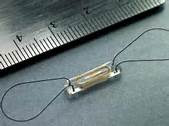August 14th, 2014
The CardioMEMS HF System: What Do You Say to Your Patient?
John Ryan, MD
This post is the fourth in our series “What Do You Say to Your Patient?” In this series, we ask members to share with us how they interpret a complex or controversial issue for patients. To review earlier posts, click here.
The following scenario stems from the recent FDA approval of the CardioMEMS HF System.
Your 45-year-old male patient with a five-year history of systolic heart failure (HF) comes in for follow up.
When you first began seeing him three years ago he required three hospitalizations for HF exacerbations within the first year. He has been stable on beta-blockers, ACE inhibitors, spironolactone, and lasix treatment for the past two years and has not needed hospitalization for more than 18 months.
Your patient has a CRT-D in place and his LVEF is 40% and stable (previously 30%). He has heard of the new CardioMEMS device and is wondering if he should get one placed.
What do you tell him?
How do you discuss the risks and benefits with him?
Who do you tell him will be following the data the device produces? Will you? Will you assign it to a nurse practitioner?


” First do not harm” !
This patient has been stable for a long time; his myocardial function doesn’t deteriorate. I do not advise the placement of this new device but tell him it could be useful in the future.
What do you tell him?
For the moment is not necessary in your case. You have not required hospitalization for HF in the past year and your condition is stable. The costs are high. First if necessary we can use alternative technique like impedance cardiography to improve control.
How do you discuss the risks and benefits with him?
The benefits is for patients in class III heart failure who had been hospitalized for heart failure in the previous 12 months. You must have a pulmonary artery branch diameter sized between 7mm and 15mm. Without a history of recurrent pulmonary embolism or deep vein thrombosis no major cardiovascular event in the past 2 months and not contraindications for dual antiplatelet or anticoagulants for one month post implant. If your BMI is greater than 35 and the chest circumference is > 65 in you are not a candidate.
First I will recommend the use of impedance cardiography.
Who do you tell him will be following the data the device produces? Will you? Will you assign it to a nurse practitioner?
I will.
His question will come upon me unexpectedly.
First I want to earn time, I’ll ask him to go into my examination room…
During the time necessary to him to undress, I run toward UptoDate* (not found in 60 secondes) and then dr Google* (found!).
Thereafter I’ll feel more comfortable to explain him: he is not a candidate, due to his stable condition and his good medication compliance. He does not necessitate any device of this kind at this moment (and I hope so for a good while!)
Benefits and risk: Too soon. It’s an invasive procedure. It can help us (you and me) to adapt the treatment? May be ?
Buy a podometer and a balance (if not already done) To my knowledge no harm and low cost devices. Measure your walking distance every day, keep your weight and salt diet steady.
The Follow-up?
Sure I will 24/7!